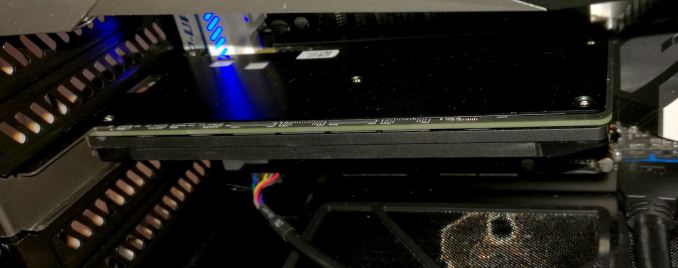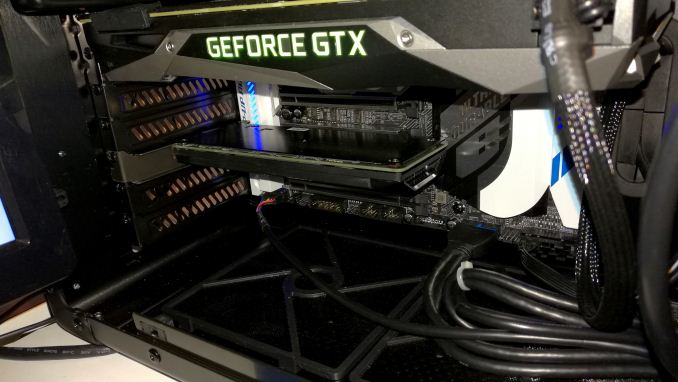Intel’s 140GB Optane 3D XPoint PCIe SSD Spotted at IDF
by Ian Cutress on August 26, 2016 12:01 PM EST- Posted in
- SSDs
- Intel
- Enterprise
- Enterprise SSDs
- 3D XPoint
- IDF_2016
- Optane

As part of this year’s Intel’s Developer Forum, we had half expected some more insights into the new series of 3D XPoint products that would be hitting the market, either in terms of narrower time frames or more insights into the technology. Last year was the outing of some information, including the ‘Optane’ brand name for the storage version. Unfortunately, new information was thin on the ground and Intel seemed reluctant to speak any further about the technology that what had already been said.
What we do know is that 3D XPoint based products will come in storage flavors first, with DRAM extension parts to follow in the future. This ultimately comes from the fact that storage is easier to implement and enable than DRAM, and the characteristics for storage are not as tight as those for DRAM in terms of break-neck speed, latency or read/write cycles.
For IDF, Optane was ultimately relegated to a side presentation at the same time as other important talks were going on, and we were treated to discussions about ‘software defined cache hierarchy’ whereby a system with an Optane drive can define the memory space as ‘DRAM + Optane’. This means a system with 256GB of DRAM and a 768GB Optane drive can essentially act like a system with ‘1TB’ of DRAM space to fill with a database. The abstraction layer in the software/hypervisor is aimed at brokering the actual interface between DRAM and Optane, but it should be transparent to software. This would enable some database applications to move from ‘partial DRAM and SSD scratch space’ into a full ‘DRAM’ environment, making it easier for programming. Of course, the performance compared to an all-DRAM database is lower, but the point of this is to move databases out of the SSD/HDD environment by making the DRAM space larger.
Aside from the talk, there were actually some Optane drives on the show floor, or at least what we were told were Optane. These were PCIe x4 cards with a backplate and a large heatsink, and despite my many requests neither demonstrator would actually take the card out to show what the heatsink looked like. Quite apart from which, neither drive was actually being used - one demonstration was showing a pre-recorded video of a rendering result using Optane, and the other was running a slideshow with results of Optane on RocksDB.
I was told in both cases that these were 140 GB drives, and even though nothing was running I was able to feel the heatsinks – they were fairly warm to the touch, at least 40C if I were to narrow down a number. One of the demonstrators was able to confirm that Intel has now moved from an FPGA-based controller down to their own ASIC, however it was still in the development phase.

Click through for high resolution
One demo system was showing results from a previous presentation given earlier in the lifespan of Optane: rendering billions of water particles in a scene where most of the scene data was being shuffled from storage to memory and vice versa. In this case, compared to Intel’s enterprise PCIe SSDs, the rendering reduced down from 22hr to ~9hr.
It's worth noting that we can see some BGA pads on the image above. The pads seem to be in an H shape, and there are several present, indicating that these should be the 3D XPoint ICs. Some of the pads are empty, suggesting that this prototype should be a model that offers a larger size. Given the fact that one of the benefits of 3D XPoint is density, we're hoping to see a multi-terabyte version at some point in the distant future.
The other demo system was a Quanta / Quanta Cloud Technology system node, featuring two Xeon E5 v4 processors and a pair of PCIe slots on a riser card – the Optane drive was put into one of these slots. Again, it was pretty impossible to see more of the drive aside from its backplate, but the onscreen presentation of RocksDB was fairly interesting, especially as it mentioned optimizing the software for both the hardware and Facebook.
RocksDB is a high-performance key/store database designed for fast embedded storage, used by Facebook, LinkedIn and Yahoo, but the fact that Facebook was directly involved in some testing indicates that at some level the interest in 3D XPoint will brush the big seven cloud computing providers before it hits retail. In the slides on screen, the data showed a 10x reduction in latency as well as a 3x improvement in database GETs. There was a graph plotted showing results over time (not live data), with the latency metrics being pretty impressive. It’s worth noting that there were no results shown for storing key/value data pairs.
Despite these demonstrations on the show floor, we’re still crying out for more information about 3D XPoint, how it exactly work (we have a good idea but would like confirmation), Optane (price, time to market) as well as the generation of DRAM products for enterprise that will follow. With Intel being comparatively low key about this during IDF is a little concerning, and I’m expecting to see/hear more about it during Supercomputing16 in mid-November. For anyone waiting on an Optane drive for consumer, it feels like it won’t be out as soon as you think, especially if the big seven cloud providers are wanting to buy every wafer from the production line for the first few quarters.
More images in the gallery below.




















66 Comments
View All Comments
Khato - Friday, August 26, 2016 - link
Except for that minor detail where Intel stated that one of the target markets for 3D XPoint was PC gaming. It is valid to question how long it's going to be until we actually see it available in that space though, since it's basically a given that Intel's going to be selling as much as it can at the higher server margins before releasing consumer products. But if I had to guess, I'd put it closer to a year from now rather than 5+.ewitte - Sunday, August 28, 2016 - link
The first to release devices on the roadmap are in the mainstream performance section with enterprise being the beginning of next year. There tends to be additional components, reliability and testing in enterprise markets.Murloc - Saturday, August 27, 2016 - link
you're making links that do not exist.Morawka - Saturday, August 27, 2016 - link
who cares what Facebook did to Oculus. it still sells like hot cakes and you can still run software and games from any company/developer and use it on the HMD.Most of the exclusive money was justified because Facebook footed the entire bill for development. Sure there are 2 or 3 games that signed exclusivity near the end of development, but you need to be mad at those developers and not facebook over that one.
If you are unhappy with facebook using your info to sell ads, then just dont use it man. It's a choice, and just like a opinion, everyone has a choice.
Oculus was open all the way until CV1 launch. When the consumer version hit, that's when open-ness ended. It was completely open from the initial prototype, all the way through the end of DK2's lifespan.
HTC has it's own exclusives like Dota Spectator VR, LAB, etc.. where they purposely omitted Xbox controller support, therefore making them un-usable. Maybe they will work once touch is out, but thats not today, so it's exclusive to HTC without using the word "exclusive"
edzieba - Friday, August 26, 2016 - link
"Then, behind closed doors, offer large sums of money to VR game developers (such as Croteam and their Serious Sam IP) to develop their games exclusive to Oculus Rift (with no support to HTC's Vive or Razer's OSVR). "A commonly repeated talking point, but not actually true.
Croteam: http://uploadvr.com/oculus-denies-seeking-exclusiv...
Other Ocean (Giant cop): http://uploadvr.com/giant-cop-speaks-oculus-exclus...
Super Hot: http://superhotgame.com/2016/06/15/3-years-of-vr-h...
It makes for a nice story to get riled up over, but it hasn't actually happened.
Shadow7037932 - Friday, August 26, 2016 - link
That's fine. This isn't going to be a consumer level tech any time soon.MamiyaOtaru - Sunday, August 28, 2016 - link
facebook arguably turned oculus into a closed platform, and you can worry about oculus stuff spying on you or whatever, but worrying about a storage technology? You think Intel's going to let them add in phone home or ad serving stuff to the firmware or something?Michael Bay - Monday, August 29, 2016 - link
Once upon a time, there was a talk about adding what would be now called a paywall to CPU extensions.fanofanand - Monday, August 29, 2016 - link
I remember this, that was one of the ways they were looking at "product differentiation". Competition prevents stuff like that.CaedenV - Friday, August 26, 2016 - link
um... wut?1) Facebook has not destroyed OR. In fact it is doing better than most people expected.
2) They are collaborating closely means that FB is telling Intel what specific feature sets, performance levels, and system hooks they want, and Intel is trying to build that into the device. It doesn't mean that FB is designing the device. It means they are putting out requests, Intel is designing a device, and FB is doing some real-world testing for Intel. This is a perfectly normal and healthy business relationship and it will help several other companies that buy into this tech.
3) OR is a consumer product. 3DxPt is a business class (and very large business class) product that the general public probably wont see for another 10 years or more, if at all because it will likely morph into a completely different product before the tech trickles down to us. It is an apples and bananas comparison.